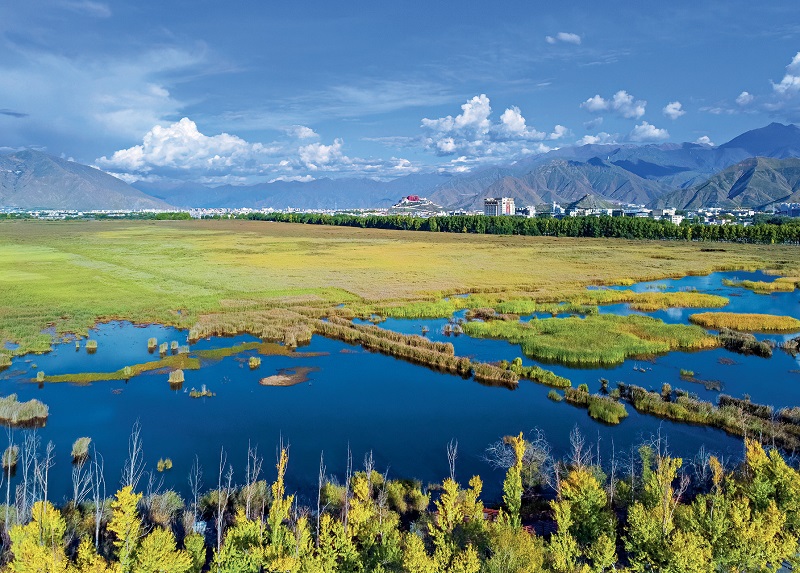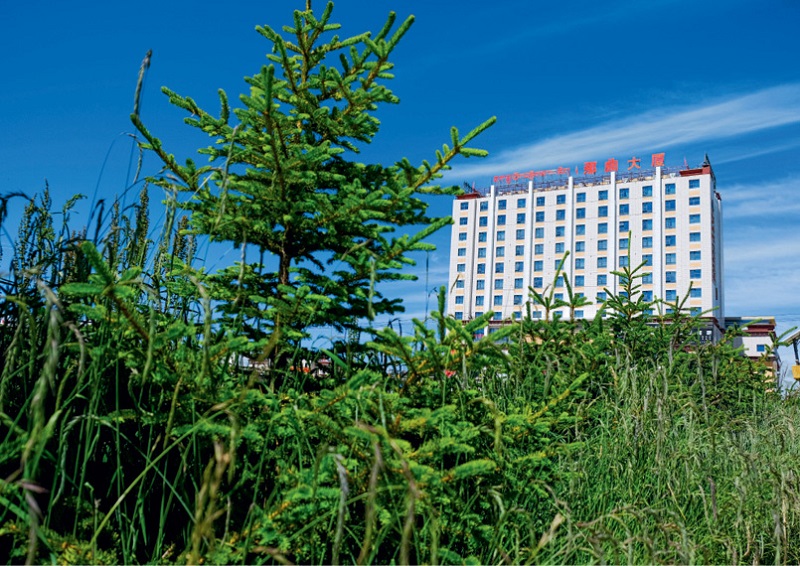
A stunning view of the Lhalu Wetland in Lhasa, Xizang Autonomous Region.
Lhalu means a large reed marsh in the Tibetan language. The Lhalu Wetland at the heart of Lhasa in Xizang Autonomous Region is the world's highest and largest urban natural wetland, dubbed “the lungs of Lhasa.”
But it was not always like that. Ngawang Tashi, who was born in Lhasa and grew up there, remembers how it was when he was young: “There were litters everywhere, people burned the reeds for fuel, and it looked like a desert.”
The turning point came in 2005, when the Lhalu Wetland was designated a national nature reserve and measures were taken to clean it up and manage it.
In 2020, a trail in the wetland was opened to the public, drawing a large number of visitors.
Since then, Diga, who lives nearby, has become a regular visitor. “My little grandson loves watching the water birds,” he said, praising the fresh air with abundant oxygen.
A Paradise for Birds
The wetland has become a paradise for birds. Lhamo Tsering, director of the Lhalu Wetland National Nature Reserve Administration, said that in 2009, a pair of rare black-necked cranes chose to settle there and are now regarded as the guardians of the wetland.
With the improved environment, the wetland’s biodiversity has improved remarkably. It is now home to around 435 plant species and 40 animal species under state protection. Besides, over 160 bird species can be found here. They include rare and endangered species like the bearded vulture. Lhamo Tsering said the painted stork, a rare bird under Grade-I protection, spent last winter in Lhalu for the first time. Its visit was living proof of the conservation achievement at the wetland, she added.
Nanshan Park on the south bank of the Lhasa River across the imposing Potala Palace offers a panoramic view of lush mountains from its observation deck at 4,000 meters above sea level. It is hard to imagine that 10 years ago these mountains were desolate, bereft of greenery.
Li Baoping, an official of the Lhasa Municipal Forestry and Grassland Administration, still remembers what it looked like when he first came here in the late 1990’s. There was only a patch of grassland on the mountains within the city. The change began in 2012, the year in which Li and his team began planting trees on the mountains.
“We planted every single tree with our own hands,” Li described the arduous mission. “The saplings had to be transported uphill either on human back or on animal back. We transported more than 30 saplings on a good day. Even on the worst days, the number would not be less than 20. To plant them, we had to dig deep holes in the mountains using iron shovels. It was not easy as the soil was sandy and full of stones. The shovels broke and had to be replaced frequently. After planting the saplings, they had to be watered regularly.” Li held out his hands, which were covered with calluses.
Taking 37 Steps
Xizang’s first massive mountain afforestation project was launched in capital Lhasa in 2021. The goal is to create forests covering 137,800 hectares by 2030. So far, over 86 million trees have been planted.
Planting trees in such high altitude is no easy task. For example, Nanshan Park itself has an average altitude of 3,900 meters. The air is rarified and the terrain is hard. Li said 37 steps are required to ensure each tree can survive, from the selection to planting and fertilizing the saplings. Each step is crucial.
To overcome the water scarcity, a pump was built on the mountains. The team, Li said, regarded the saplings as their children, feeling like proud parents when they thrived and grew.
Today, Nanshan Park is a top leisure destination for local residents.
“I heard that the view of the Potala Palace from Nanshan Park is stunning and you can also get a view of entire Lhasa,” said a tourist from Shandong Province, who declined to be named.
“We came here specifically for that. I didn’t expect the park to be so well-maintained. It is green, with bridges and streams. Later, I’ll head to the mountaintop to watch the sunset and capture that wonderful moment with my camera.”

A row of dragon spruce trees thriving in downtown Nagqu City.
The City that Had No Trees
Nagqu in Xizang was once the only city in China without trees. With an average altitude above 4,500 meters, the region has thick permafrost, freezing temperatures and strong winds. Farming was possible only about 100 days a year. However, using science and technology, the treeless city has been transformed into a green miracle.
The main road leading to the center of the city is now a greenbelt lined with rows of highland willows.
In 1998, the first experimental base for planting trees was established in the office compound of the local agriculture and animal husbandry administration, and planting started with saplings brought from the Ngari, 1,500 km away. However, the results were not encouraging. Then in 2007, different tree species such as a kind of willow, poplars and the evergreen dragon spruce were planted on a trial basis. Only about a dozen of these trees survived and are now the oldest trees in the area.
The experimentations continued. In 2016, a demonstration project was launched to research and develop key technologies for afforestation and provide technological support for the greening.
After years of relentless efforts, by September 2021, Nagqu had successfully planted trees in every community under 4,300 meters. Today, trees can be seen everywhere in the city that once had no trees.
The green miracle on a high plateau, driven by science and technology and years of hard work, is a conservation success, improving the environment and benefiting the local residents.